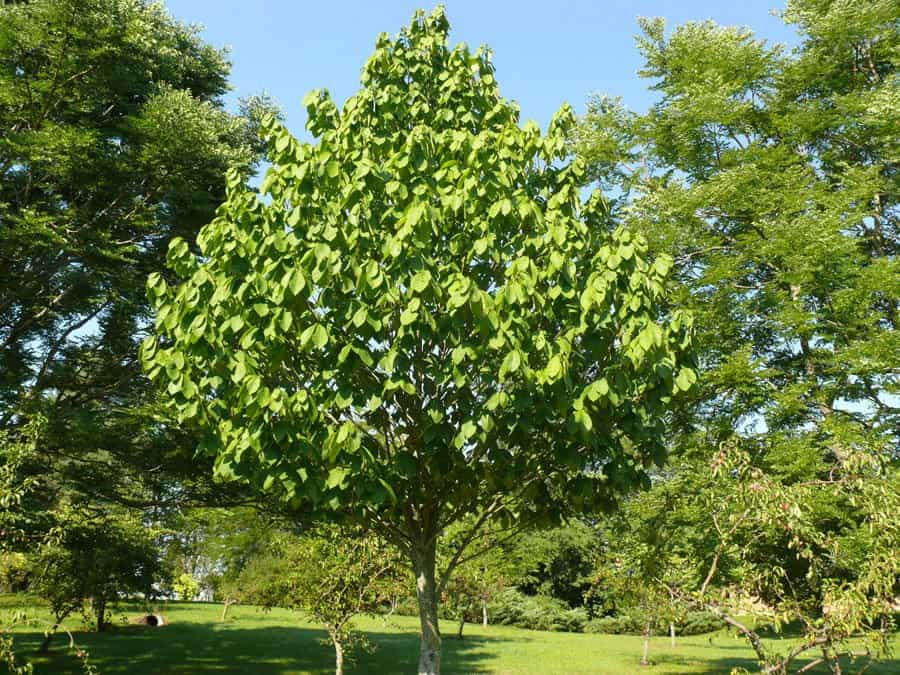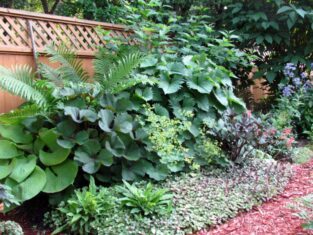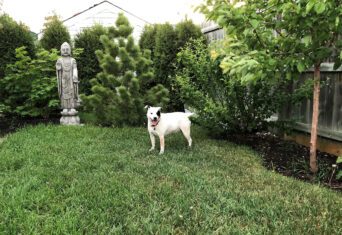
Until the recent frenzy that saw chefs clamouring to add pawpaws to their menus, the only time you may have heard of this sweet fruit (sometimes described as tasting like banana, guava and persimmon, all rolled into one creamy fruit) was in the lyrics of a traditional American folk song: “Pickin’ up pawpaws, puttin’ ’em in your pockets.”
But its culinary popularity is making pawpaw trees (Asimina triloba) the next big thing for backyard gardeners, too. Linda Grimo of Grimo Nut Nursery, in Ontario, thinks this native of Carolinian forests, which up until recently has been relatively unknown to Canadian gardeners, is an ideal tree for the urban landscape. Hardy to Zone 6, the pawpaw is a small tree with a beautiful, pear-shaped form and glossy, almost tropical-looking leaves. Although it can grow as tall as 20 feet (6 m), the upper branches taper to a narrow point, while the lower limbs spread only 6.5 to 10 feet (2 to 3 m), making it seem smaller than it is. Because it’s an understorey tree accustomed to growing beneath the protective canopy of the forest, it’s well suited to city or suburban gardens where buildings and other trees shelter it from the wind and direct sun. Pawpaws show little susceptibility to pests and disease, which also makes them a popular choice for organic gardeners.
To produce fruit, the purple, bell-shaped flowers need to be cross-pollinated (commonly by carrion flies and beetles), so ask the grower for genetically unrelated specimens. Plants can be spaced as close as five feet (1.5 m) apart. Grimo Nut Nursery ships dormant, bare-root trees in the spring, which is the best time to plant pawpaws. “This ensures they are in the ground at the ideal time and have a summer to put on growth and establish a strong root system,” Grimo says. Because their roots dry out easily, keep them wrapped until the planting hole is ready. When planting, spread out the roots and carefully backfill the hole so as not to compact the fragile roots.
Once in the ground, Grimo recommends leaving a two-foot (60-cm) circle of mulch around the base of the tree to suppress weeds and hold moisture in the soil. (Keep mulch away from the trunk to prevent rot and fungal disease.) Watering is dependent on the weather, she says, but in weeks where there’s no rainfall, water every three or four days for the first year; in the second year, water only during periods of drought that last more than nine days. After that, the tree should be able to survive on its own.
The fruits are chubby and slightly crescent-shaped, and begin to soften like a mango when ripe. It takes five to seven years for a tree to produce fruit, but most seedlings are two to three years when sold. So it won’t be long before you’ll be pickin’ up your own pawpaws and puttin’ ’em in — ice cream, mousse, puddings, fruit salads, or spooned fresh into your mouth.









I have several pawpaw, but of the 2 that are old enough to fruit, one seems to have died, even though it was a beautiful healthy tree last year, so I have no idea why. But the other one outdid itself and produced about 40 blooms this year. It bloomed for the first time last year with 2 blooms. Since there is no other pawpaw anywhere nearby, I decided it wouldn’t hurt to self pollinated it and see if it was possible, even though it isn’t supposed to be possible. These are all native pawpaw trees. I took the pollen from 3 or 4 blooms that had opened first and were starting to open their pollen, and pollinated all the fresh young blooms. There were also many flies, beetles, and spiders helping me. The pollen took in most of the flowers I pollinated and several I didn’t as well. Each has between 3 and 7 pawpaw growing now. So there will be about 60 pawpaws ripening on that poor little tree if they all stay on. The tree is only 6 feet tall. So it most certainly is possible to get pawpaw to set fruit with only one tree. I have pictures, but see no way to post them unfortunately.
I am interested in growing a PawPaw tree. What soil condition do they like? We are south enough but on “solid” clay.
I live in Brampton, Ontario. Would pawpaw tree survive winters in Brampton and where can I buy pawpaw tree. How long it takes to pawpaw tree to have fruits after planting.
Hi! Thanks for the article. Anyone knows if they’d survive in Montreal?
Wow you’ve really done your research lol! We actually just started a series and did an article on the Pawpaw as well and wanted to share with you or your readers a little bit more about this pretty unique tree. We’re arborists so we love this type of stuff!
If you’re interested in reading or having a link to us, take a look at our article:
http://devostree.ca/native-tree-of-the-week-pawpaw-tree/
HI! It is written that we can plant them as close as 5 feet, but we were wondering how far appart can we put them before they stop pollinating each other? thanks!
No more than 20 feet apart or they may not pollinate. Follow me on YouTube at Hillside Homesteading. We grow pawpaws in Ontario.
These trees are awesome I’ve had mine planted since 2013 and they have flowers on them this year! Also good to know the trees are rabbit and deer resistant and they really do not like to be moved so make sure you pick a planting spot where they have room to grow!
How fast do they grow?
They are also growing at the Dominion Arboretum in Ottawa. Happy, but well located.
Hi Gabriella,
Toronto has many micro-climates, and in the city core pawpaws should do very well. They’re growing in the gardens of the Toronto Botanical Garden, which is located at Leslie and Lawrence, so I think as long as you’re south of the 401, they should do well.
Would they do well in Toronto,Ontario?
I know of a couple of Pawpaw trees growing north of the 401 in the GTA which produce fruit. Furthermore, Pawpaw has been planted successfully way up in Meaford, by Georgian Bay.
There are paw paw trees in Mount Pleasant cemetery. I also have a dozen or so threes in Antigonish Co. Nova Scotia. These trees have never shown any winter kill and bear fruit.
Robert
wow, wish I could grow them in northern nb, where do you buy the trees?
Whiffletree farms sells them.
Hi, I live in the valley and being trying to find native pawpaw to start a orchard, would you be welling to sale done seeds or small clippings that I could try to start and grow?